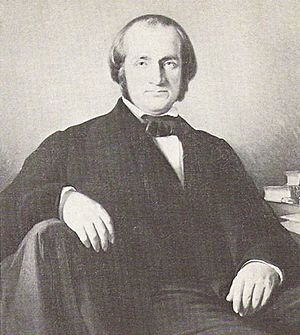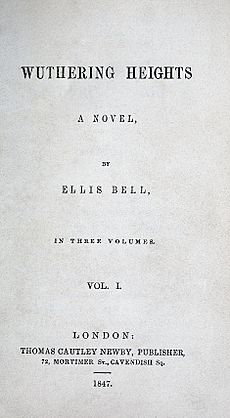Emily Brontë facts for kids
Quick facts for kids
Emily Jane Brontë
|
|
|---|---|

The only undisputed portrait of Brontë, from a group portrait by her brother Branwell
|
|
| Born | 30 July 1818 Thornton, West Riding of Yorkshire, England |
| Died | 19 December 1848 (aged 30) Haworth, West Riding of Yorkshire, England |
| Pen name | Ellis Bell |
| Occupation |
|
| Nationality | English |
| Genre |
|
| Literary movement | Romantic Period |
| Notable works | Wuthering Heights |
| Relatives | Brontë family |
Emily Jane Brontë (born 30 July 1818 – died 19 December 1848) was an English writer. She is famous for her only novel, Wuthering Heights. This book is now seen as a classic in English literature.
Emily was one of the four Brontë children who lived to be adults. She was older than her sister Anne and younger than her brother Branwell. Emily used the pen name Ellis Bell when her books were published.
Contents
Early Life and Learning

Emily Brontë was born on 30 July 1818. She was born in a village called Thornton in Yorkshire, England. Her parents were Maria Branwell and Patrick Brontë. Emily was the fifth of six children. Her older sister was Charlotte Brontë.
In 1820, Emily's family moved to Haworth. Her father worked there as a church minister. The Brontë children grew up here and became very good at writing.
When Emily was three, her mother died. Her older sisters, Maria, Elizabeth, and Charlotte, went to a school called Clergy Daughters' School. This school was very strict and difficult. Emily joined them for a short time in 1824.
Sadly, a sickness spread at the school. Maria and Elizabeth became very ill. Both of them died soon after. Emily, Charlotte, and Elizabeth were taken home in 1825. Elizabeth also died shortly after returning home.
After this, Emily, Charlotte, Anne, and their brother Branwell were taught at home. Their father and aunt, Elizabeth Branwell, taught them. Emily was a shy girl. She was very close to her siblings. She loved animals, especially stray dogs.
Even without formal school, the Brontë children read many books. They enjoyed writers like Sir Walter Scott and Byron.
In their free time, the children made up stories. They were inspired by toy soldiers Branwell received. They created imaginary worlds, like 'Angria' and 'Gondal'. They wrote stories and acted out adventures for their toy soldiers. Not many of Emily's early writings still exist.
When she was seventeen, Emily went to Roe Head Girls' School. Charlotte was a teacher there. But Emily felt very homesick and only stayed for a few months. The sisters hoped to get enough education to open their own school one day.
Adult Life and Writing

In 1838, when Emily was twenty, she became a teacher. She worked at Law Hill School in Halifax. The work was very hard, with 17-hour days. Her health suffered, and she came home in 1839.
After that, Emily stayed home. She did most of the cooking and cleaning. She also taught herself German from books. She practiced playing the piano too.
In 1842, Emily went with Charlotte to a school in Brussels, Belgium. It was called the Héger Pensionnat. Emily did not like Brussels as much as Charlotte did. She didn't want to follow Belgian fashion. She said, "I wish to be as God made me." This made her feel like an outsider. The sisters wanted to improve their French and German. They still hoped to open their own school.
Emily and Charlotte studied hard. They became very good at French. The school even offered them teaching jobs. But their aunt became ill and died. So, they had to return to Haworth. They tried to open a school at their home. However, they couldn't find any students because their home was in a remote area.
In 1844, Emily started to organize her poems. She copied them neatly into two notebooks. One was called "Gondal Poems." The other had no label. Around this time, she wrote one of her most famous poems, "No coward soul is mine."
In 1846, the sisters published their poems together. The book was called Poems by Currer, Ellis, and Acton Bell. They used pen names to keep their real identities private. Charlotte was "Currer Bell," Emily was "Ellis Bell," and Anne was "Acton Bell."
Personality and Character
Most of what we know about Emily comes from her older sister, Charlotte. Charlotte wrote about Emily after she died.
People often described Emily as very shy. She was not very social. But she had a "warm, human side" that showed in her love for nature and animals.
Eva Hope, a writer from 1886, said Emily was a mix of shyness and bravery. She wrote that Emily was "painfully shy, but physically she was brave." Emily loved a few people very deeply. She was understanding of others' mistakes. But she was very strict with herself. She always tried to do what she thought was right.
Wuthering Heights

Emily Brontë's novel, Wuthering Heights, was first published in 1847. It came out in London. It was part of a three-book set that also included Anne Brontë's Agnes Grey. The authors were listed as Ellis and Acton Bell. Emily's real name wasn't known until 1850.
When Wuthering Heights first came out, critics were a bit confused by its new style. The book had strong emotions and some violence. Many people thought a man must have written it. Reviewers were impressed, confused, and even shocked by its powerful language.
At first, the book got mixed reviews. Some people didn't like its strong, wild passion. But over time, Wuthering Heights became a classic of English literature. Emily Brontë never knew how famous her only novel would become. She died just a year after it was published, when she was only 30 years old.
Emily's publisher once said she had started a second novel. But this book was never found. Maybe Emily or her family destroyed it. This might have happened if she was too sick to finish it. Some people think the letter might have been for Anne Brontë. Anne was already writing her second novel, The Tenant of Wildfell Hall, at that time.
Related pages
The sisters of Emily Brontë:
The books of Emily Brontë:
- Poems by Currer, Ellis and Acton Bell (1846)
- Wuthering Heights (1847)
Images for kids
-
Portrait painted by Branwell Brontë in 1833; sources are in disagreement over whether this image is of Emily or Anne.
See also
 In Spanish: Emily Brontë para niños
In Spanish: Emily Brontë para niños



